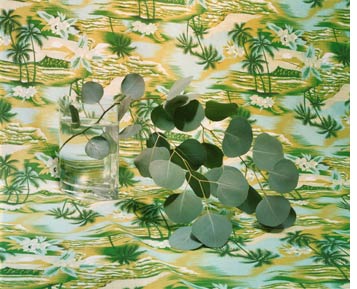“Modernity Circa 1962, Mirrored and Reflected Infinitely” (2004)
"Endlessly Repeating Twentieth Century Modernism" (2007)
Many of his works also have a cosmological theme. These works, based on the Big Bang theory, were developed with the help of an astronomer from Ohio State University. Tom McDonough, the author of "Shadow Play" gives the following explanation for these works:
"At mid-century, when the phrase 'Big Bang' was itself coined, both modernist design and science shared a kind of inhumane elegance that is the very basis on which the techno-scientific and aesthetic meet. It is this, rather than the technicalities of astrophysics, which the artist has been exploring these past five years."
The following image and link talk about the work "Island Universe". On the page that the link directs to, there is a short video of an Art21 video in which McElheny talks about the Big Bang theory and how it relates to modernism and his work. http://blog.art21.org/2008/10/15/josiah-mcelheny-at-white-cube/
"Island Universe" (2008)
In his Art21 segment, McElheny also talks about the idea that primitive societies tend to decorate, and as people become more self-conciously modern, there is a tendency to remove decoration from daily life, opting instead for purity and pure forms. It is this utopian vision that Buckminster Fuller and Isamu Noguchi imagined, and it is again
One question that I still have regarding this artist is about the idea of modernism in a contemporary setting. How can a contemporary artist refer to and praise the ideas of mid-century modernism without his work seeming antiquated and unnecessary? Indeed, McElheny's works seem fresh and insightful, despite their similarities to and direct appropriation of the works of artists like Noguchi and Brancussi.
One answer to this question may lie in my discussion of another set of his works which talk about history and fiction, and how they are tied to objecthood. In this series of works, McElheny produced bases, were glass vases, based on dresses designed in the middle of the 20th century.
"From an Historical Anecdote about Fashion" (2000)
In this work, McElheny uses the vases to discuss the idea of history and objecthood, and how stories become transferred through these objects. As far as I can tell, he is using these modernist forms (in all of his work) not just to praise modernism as a whole, but to a vehicle to talk about those ideas of modernism which he believes may still resonate with the contemporary viewer. These ideas of placing oneself in the context of history, and using the past to come to terms with how we understand our experience in the present, seem to be central to his works. I also believe that his use of modernism does not necessarily just reference the movement, but the definition of being "modern" as a self descriptor of one who questions their place in history and the ideologies of their time.





























.jpg)


.jpg)










